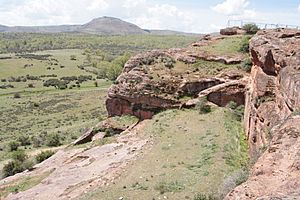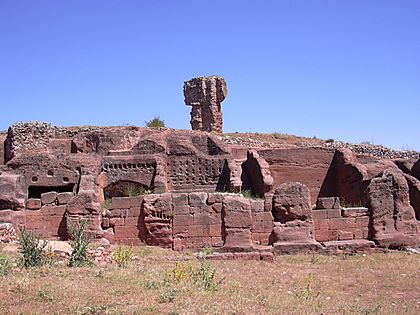Termantia facts for kids
Imagine a city carved right out of rock! That's what you'll find at Tiermes, also known as Termantia in ancient times. This amazing archaeological site is in Spain, near the Duero river valley. It's located in a quiet area called Montejo de Tiermes, in the Soria region.
Long ago, during the Iron Age, Tiermes was a strong Celtiberian hill fort. The Celtiberians were ancient people who lived in Spain. Tiermes was brave and fought against the powerful Romans. It even teamed up with another famous city, Numantia, during the Celtiberian Wars. The Romans later called the city Termes or Termantia. What makes Tiermes special is how many of its buildings were carved directly into the red sandstone rock of the hill.
Contents
Tiermes and the Roman Empire
The people of Tiermes were likely wealthy from raising sheep. They might have moved their flocks between different areas each year. There were also iron and other metal mines nearby, which added to their wealth.
The Romans spent a long time conquering Spain. The Celtiberian Wars were a big part of this. Tiermes was attacked by a Roman leader named Q. Pompey in 141 BC. Later, in 139 BC, Tiermes and Numantia signed a peace treaty with him. However, the Roman Senate (their government) didn't agree with the treaty.
Even though fighting continued, Tiermes wasn't directly affected for a while. But in 98 BC, the Romans attacked again. The Roman consul Titus Didius captured Tiermes. He made the people move down to the flat land below the hill. This move only lasted for about ten or twenty years. After this, Tiermes had to pay taxes to Rome. This was the start of the city becoming more Roman.
Around 70 BC, the city began a big makeover. They used the three natural levels, or terraces, of the hill. The most important buildings were planned for the middle terrace.
Becoming a Roman City
Tiermes probably became a Municipium when Emperor Tiberius was in charge. A municipium was a Roman city that had some self-governance. This meant its citizens had certain rights, similar to Roman citizens. Tiermes then became part of a larger Roman district called Conventus Cluniensis.
The city grew a lot between the first and second centuries AD. This was its golden age. It got many large public buildings. These included two fora (public squares), thermal baths, and possibly a theater. An aqueduct brought water to the city. The city was well-planned for its location on a sandstone cliff, surrounded by rivers and forests.
One of the most amazing things about Tiermes is how buildings were carved into the solid rock. The Romans improved these building methods. You can still see many examples of this. There are private homes, like the "House of the Niches," and public buildings, like rock bleachers. Even parts of the aqueduct and drainage systems were carved into the rock.
Around the late 200s AD, a wall was built around the city. This shows that Tiermes remained an important place until at least the mid-300s AD. However, Tiermes slowly became less important during the late Roman period.
Later History of Tiermes
We don't know much about what happened in Tiermes during the time of the Visigoths or the Islamic period. Today, there is a Romanesque church there. Since the area is not very populated now, this church is called an eremita, which means a hermitage.
Exploring the Archaeology
The ancient remains of Tiermes are found on different terraces and on the flat land to the south.
- Rock-Cut Steps: These are large public steps carved into the rock. We're not sure exactly when they were built or what they were used for. They are near the "Door of the Sun," which was one of the old entrances to the city.
- Southern Rock Homes: These are homes likely from the Celtiberian time. They were carved into the rocks, sometimes with two floors. The front parts were built with stone by the Romans. There are 11 houses in two groups, separated by stairs. One, called the "House of the Niches," also had an upper floor.
- Aqueduct Channel: This channel was carved into the rock. It brought water from the hill to the Roman city. Parts of it ran underground.
- West Gate: This was an entrance for people walking into the city.
- "House of the Aqueduct": This was a very large house, about 1800 square meters, with 35 rooms. It had different levels connected by stairs. The base was cut into the hill, and the walls were decorated with paintings.
- Forum: This area had a temple for worshipping the emperor. It also had a public square with arches and a macellum (a market) with shops.
In 2018, scientists used special tools to look underground. This is called magnetometry. It helped them find new areas where houses once stood inside the city walls. They also found unknown structures outside the city, especially to the west and east. The western structures might be even older than the Roman city, perhaps part of the Iron Age hilltop settlement. We don't know the age of the eastern structures yet.
Gallery
-
Sculpture now in the National Archaeology Museum
Protecting Tiermes and Its Museum
The site of Tiermes is very important, so it's protected by Spanish law. It's listed as a Zona Arqueológica (Archaeological Zone).
There is a museum right at the site, which is connected to the Numantine Museum of Soria. A group called the Friends of the Tiermes Museum (AAMT) was started in 1988. This group works to protect the environment and promote sustainable tourism. Sustainable tourism means visiting a place in a way that helps protect it for the future.
From 2003 to 2006, a program called the European LIFE Programme helped fund projects at Tiermes. This money was used to develop eco-cultural tourism in this area, which needs economic help. They worked on protecting and improving the archaeological and natural heritage.
The project also found that the area could be a Special Protection Area for birds. You might even see wolves here! A place called Encinares de Tiermes was named a Site of Community Importance in 2015. It became a Special Area of Conservation for different species.
If you visit Tiermes, you can take guided tours. You can also enjoy dark sky astronomy, which means looking at the stars in a place with very little light pollution.
See also
 In Spanish: Tiermes para niños
In Spanish: Tiermes para niños








